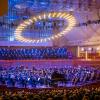
In Béla Bartók’s only opera, Bluebeard’s Castle, the walls sweat blood. Whether that makes for an ideal date night over Valentine’s Day weekend depends on just how romantic you consider an opera whose plot falls between a psychological novel and a horror movie.
Bluebeard’s Castle, which opened at Opera San José on Saturday, Feb. 15, offers plenty of both genres. Moreover, General Director Shawna Lucey brings a feminist perspective to the work, both in her sharply analytical program notes and in staging the opera.
Wealthy and powerful, Duke Bluebeard (played by baritone Zachary Nelson) has just brought his new bride, Judith (soprano Maria Natale), home to the titular castle. He’s been married before, and there are rumors about what happened to his previous wives, who haven’t been seen in some time. In the gloom of the castle, Judith sees seven locked doors –– and she’s curious about them.
We’re not entirely sure what the basis of the new couple’s relationship is, but Lucey’s conception of Bluebeard and Judith clarifies this. There’s a potent sexual connection between the two characters — they can hardly keep their hands off each other — yet at the same time, there’s a psychological struggle over whether they trust each other.

Can Judith leave those seven mysterious doors locked? Does Bluebeard trust Judith with the secrets behind the doors? They’re not the model of an ideal relationship.
Over the course of the opera, which runs just over an hour, Judith cajoles, seduces, persuades, and pressures Bluebeard into reluctantly handing over each of the keys, and that’s when we get the horror.
Behind the doors are a torture chamber, an armory full of weapons, a treasury full of gold and jewels, a beautiful garden, a view over Bluebeard’s lands, a pool of tears. Blood permeates and splatters everything, representing Bluebeard’s past actions. Like the imaginary blood on Lady Macbeth’s hands, it can never be washed away.
Bartók’s score aptly characterizes the chilling discoveries behind each door. After the dark-toned and mysterious opening, the music for the torture chamber skitters tensely. The door to the armory opens to a military march. The treasury brings forth music that glows like the gold within. The fifth door opens to Bluebeard’s vast empire with a famously awesome — and loud — C-major chord, the climax of the opera and a rare moment of tonal stability.

The Opera San José Orchestra handled this complex and difficult score with aplomb, though Music Director Joseph Marcheso could have conducted with more tension and mystery from time to time.
Bartók writes for the singers in a conversational style; there are no arias in this opera. The secretive Bluebeard, with his tightly wound personality, sings in an almost chantlike style, his vocal range restricted compared to Judith’s. The music reflects the rhythms of the composer’s native Hungarian, in which every word is accented on the first syllable. This production, at San Jose’s California Theatre, is sung in English, with English and Spanish supertitles, increasing the opera’s immediacy and accessibility. Nelson and Natale had no difficulties putting across Marcheso and Steven White’s translation of Béla Balázs’s original libretto.
The singers handled the opera’s musical and vocal demands exceptionally well, especially notable because both were making their respective role debuts. Nelson’s warmly beautiful baritone made Bluebeard an attractive figure. Despite the high-necked red cape and huge leather belt he wore, Nelson sometimes seemed more huggable than scary. He could have been more menacing.

Natale, returning to OSJ after a stint in the company’s artist-in-residence program, has a big, vibrant soprano, well suited to Judith. Her high C at the opening of the fifth door cut right through the orchestra. She sang beautifully and accurately throughout, and if her demeanor was oddly coquettish at times, Judith’s steely determination came to the fore in the end.
Lucey, scenic designer Steven Kemp, and lighting designer Michael Clark took the staging details in the libretto seriously and literally. The handsomely gloomy set, lit by many chandeliers and sconces, has seven doors of different colors, plus an array of vaguely medieval furniture.
The doors come from past OSJ productions of other operas, a sly visual pun for anyone who thought them vaguely familiar. Red and white roses that Judith strews about the stage and red-spattered handkerchiefs provide bloody visual pops. Bluebeard and Judith, both clothed in white by costume designer Caitlin Cisek, are clearly marked as newlyweds.
Lucey has directed this production with fluid imagination, heightening the dramatic tension as Bluebeard and Judith grapple for power in their marriage. Just what is behind that last door? Will Judith vanish as mysteriously as her husband’s previous wives? No spoilers, but Lucey has a few extra tricks up her sleeve — and four performances remain in which you can find the answers.
Opera San José’s production of Béla Bartók’s Bluebeard’s Castle runs through March 2.
This story was first published in Datebook in partnership with the San Francisco Chronicle.




